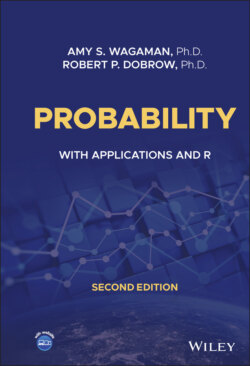Читать книгу Probability - Robert P. Dobrow - Страница 19
PROBABILITY FUNCTION
ОглавлениеGiven a random experiment with discrete sample space , a probability function is a function on with the following properties:
1
2 (1.1)
3 For all events ,(1.2)
You may not be familiar with some of the notation in this definition. The symbol means “is an element of.” So means is an element of . We are also using a generalized -notation in Equations 1.1 and 1.2, writing a condition under the to specify the summation. The notation means that the sum is over all that are elements of the sample space, , that is, all outcomes in the sample space.
In the case of a finite sample space , Equation 1.1 becomes
And in the case of a countably infinite sample space , this gives
In simple language, probabilities sum to 1. The third defining property of a probability function says that the probability of an event is the sum of the probabilities of all the outcomes contained in that event. We might describe a probability function with a table, function, graph, or qualitative description. Multiple representations are possible, as shown in the next example.
Example 1.5 A type of candy comes in red, yellow, orange, green, and purple colors. Choose a piece of candy at random. What color is it? The sample space is Assuming the candy colors are equally likely outcomes, here are three equivalent ways of describing the probability function:
1 0.200.200.200.200.20
2
3 The five colors are equally likely.
In the discrete setting, we will often use probability model and probability distribution interchangeably with probability function. In all cases, to specify a probability function requires identifying (i) the outcomes of the sample space and (ii) the probabilities associated with those outcomes.
Letting H denote heads and T denote tails, an obvious model for a simple coin toss is
Actually, there is some extremely small, but nonzero, probability that a coin will land on its side. So perhaps a better model would be
Ignoring the possibility of the coin landing on its side, a more general model is
where . If , we say the coin is fair. If we say that the coin is biased. In this text, assume coins are fair unless otherwise specified.
In a mathematical sense, all of these coin tossing models are “correct” in that they are consistent with the definition of what a probability is. However, we might debate which model most accurately reflects reality and which is most useful for modeling actual coin tosses.
Example 1.6 Suppose that a college has six majors: biology, geology, physics, dance, art, and music. The percentage of students taking these majors are 20, 20, 5, 10, 10, and 35, respectively, with double majors not allowed. Choose a random student. What is the probability they are a science major?The random experiment is choosing a student. The sample space isThe probability model is given in Table 1.1. The event in question isFinally,
TABLE 1.1. Probability model for majors.
| Bio | Geo | Phy | Dan | Art | Mus |
|---|---|---|---|---|---|
| 0.20 | 0.20 | 0.05 | 0.10 | 0.10 | 0.35 |
This example is probably fairly clear and may seem like a lot of work for a simple result. However, when starting out, it is good preparation for the more complicated problems to come to clearly identify the sample space, event, and probability model before actually computing the final probability.
Example 1.7 In three coin tosses, what is the probability of getting at least two tails?Although the probability model here is not explicitly stated, the simplest and most intuitive model for fair coin tosses is that every outcome is equally likely. As the sample spacehas eight outcomes, the model assigns to each outcome the probability The event of getting at least two tails can be written as This gives
